ACCT555 Course Project: External Audit of Smackey Dog Foods, Inc.
VerifiedAdded on 2022/08/19
|7
|3250
|20
Homework Assignment
AI Summary
This assignment provides a comprehensive analysis of the external audit of Smackey Dog Foods, Inc., covering key aspects of the audit process. It begins by discussing the Securities and Exchange Commission's (SEC) influence on the audit and the ethical principles auditors must adhere to, emphasizing audit independence. The assignment outlines the essential activities in audit planning, including understanding the client's business, assessing business risks, and setting materiality levels. It then details the four stages of the audit—planning and risk assessment, tests of control, substantive audit procedures, and audit finalization—with examples specific to Smackey Dog Foods. The assignment also addresses Keller CPAs' responsibilities regarding internal control communications, identifying issues such as commission based on estimated sales, segregation of duties in inventory, and the lack of controls for returned goods and accounts receivable. Furthermore, the assignment discusses accounts receivable confirmations, including positive and negative confirmations, and the factors affecting sample size. It covers procedures for obtaining evidence about legal encumbrances on property, plant, and equipment. The assignment concludes by addressing the auditor's presence at the year-end inventory count and the related documentation and internal control weaknesses within the inventory and warehousing cycle.
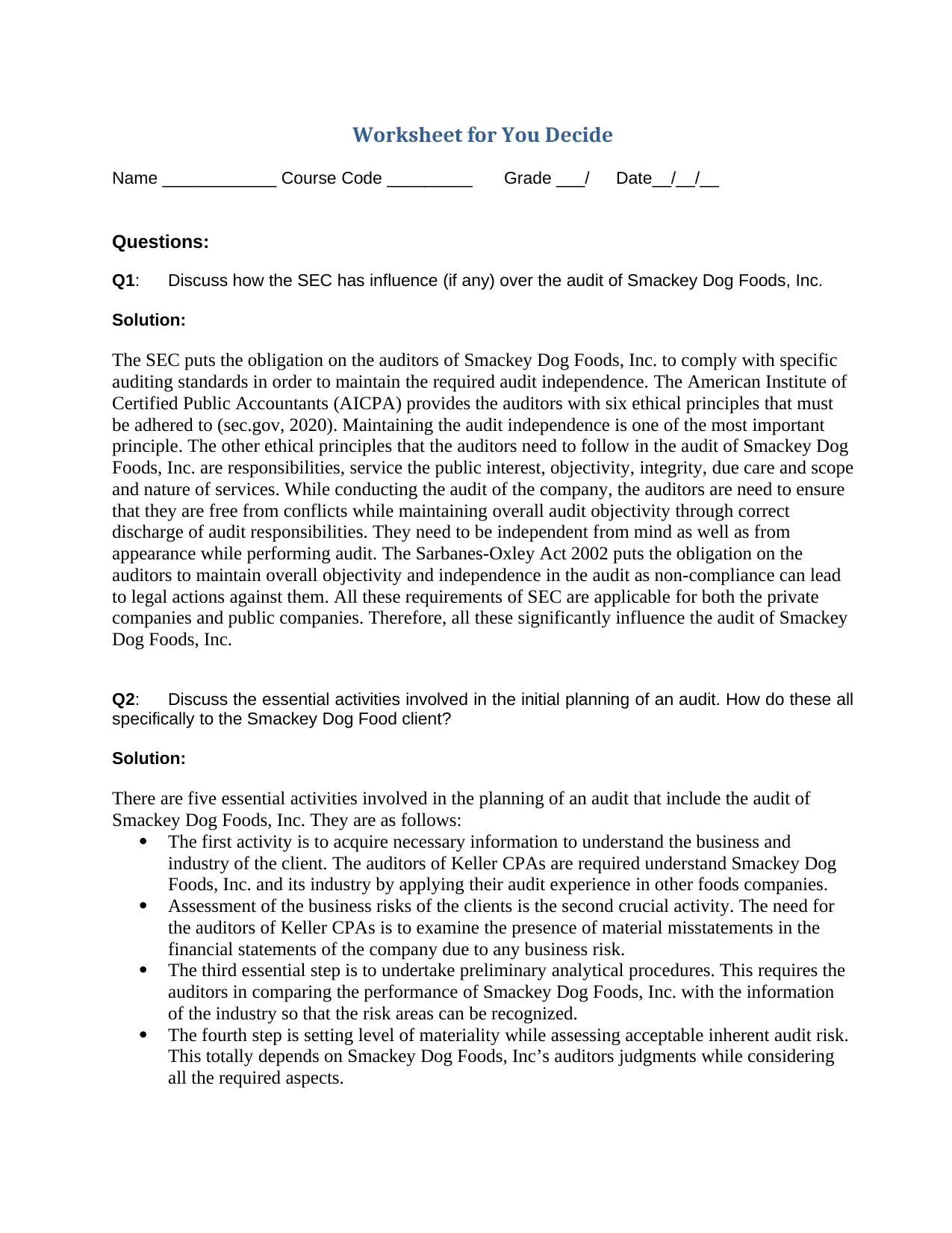
Worksheet for You Decide
Name ____________ Course Code _________ Grade ___/ Date__/__/__
Questions:
Q1: Discuss how the SEC has influence (if any) over the audit of Smackey Dog Foods, Inc.
Solution:
The SEC puts the obligation on the auditors of Smackey Dog Foods, Inc. to comply with specific
auditing standards in order to maintain the required audit independence. The American Institute of
Certified Public Accountants (AICPA) provides the auditors with six ethical principles that must
be adhered to (sec.gov, 2020). Maintaining the audit independence is one of the most important
principle. The other ethical principles that the auditors need to follow in the audit of Smackey Dog
Foods, Inc. are responsibilities, service the public interest, objectivity, integrity, due care and scope
and nature of services. While conducting the audit of the company, the auditors are need to ensure
that they are free from conflicts while maintaining overall audit objectivity through correct
discharge of audit responsibilities. They need to be independent from mind as well as from
appearance while performing audit. The Sarbanes-Oxley Act 2002 puts the obligation on the
auditors to maintain overall objectivity and independence in the audit as non-compliance can lead
to legal actions against them. All these requirements of SEC are applicable for both the private
companies and public companies. Therefore, all these significantly influence the audit of Smackey
Dog Foods, Inc.
Q2: Discuss the essential activities involved in the initial planning of an audit. How do these all
specifically to the Smackey Dog Food client?
Solution:
There are five essential activities involved in the planning of an audit that include the audit of
Smackey Dog Foods, Inc. They are as follows:
The first activity is to acquire necessary information to understand the business and
industry of the client. The auditors of Keller CPAs are required understand Smackey Dog
Foods, Inc. and its industry by applying their audit experience in other foods companies.
Assessment of the business risks of the clients is the second crucial activity. The need for
the auditors of Keller CPAs is to examine the presence of material misstatements in the
financial statements of the company due to any business risk.
The third essential step is to undertake preliminary analytical procedures. This requires the
auditors in comparing the performance of Smackey Dog Foods, Inc. with the information
of the industry so that the risk areas can be recognized.
The fourth step is setting level of materiality while assessing acceptable inherent audit risk.
This totally depends on Smackey Dog Foods, Inc’s auditors judgments while considering
all the required aspects.
Name ____________ Course Code _________ Grade ___/ Date__/__/__
Questions:
Q1: Discuss how the SEC has influence (if any) over the audit of Smackey Dog Foods, Inc.
Solution:
The SEC puts the obligation on the auditors of Smackey Dog Foods, Inc. to comply with specific
auditing standards in order to maintain the required audit independence. The American Institute of
Certified Public Accountants (AICPA) provides the auditors with six ethical principles that must
be adhered to (sec.gov, 2020). Maintaining the audit independence is one of the most important
principle. The other ethical principles that the auditors need to follow in the audit of Smackey Dog
Foods, Inc. are responsibilities, service the public interest, objectivity, integrity, due care and scope
and nature of services. While conducting the audit of the company, the auditors are need to ensure
that they are free from conflicts while maintaining overall audit objectivity through correct
discharge of audit responsibilities. They need to be independent from mind as well as from
appearance while performing audit. The Sarbanes-Oxley Act 2002 puts the obligation on the
auditors to maintain overall objectivity and independence in the audit as non-compliance can lead
to legal actions against them. All these requirements of SEC are applicable for both the private
companies and public companies. Therefore, all these significantly influence the audit of Smackey
Dog Foods, Inc.
Q2: Discuss the essential activities involved in the initial planning of an audit. How do these all
specifically to the Smackey Dog Food client?
Solution:
There are five essential activities involved in the planning of an audit that include the audit of
Smackey Dog Foods, Inc. They are as follows:
The first activity is to acquire necessary information to understand the business and
industry of the client. The auditors of Keller CPAs are required understand Smackey Dog
Foods, Inc. and its industry by applying their audit experience in other foods companies.
Assessment of the business risks of the clients is the second crucial activity. The need for
the auditors of Keller CPAs is to examine the presence of material misstatements in the
financial statements of the company due to any business risk.
The third essential step is to undertake preliminary analytical procedures. This requires the
auditors in comparing the performance of Smackey Dog Foods, Inc. with the information
of the industry so that the risk areas can be recognized.
The fourth step is setting level of materiality while assessing acceptable inherent audit risk.
This totally depends on Smackey Dog Foods, Inc’s auditors judgments while considering
all the required aspects.
Paraphrase This Document
Need a fresh take? Get an instant paraphrase of this document with our AI Paraphraser
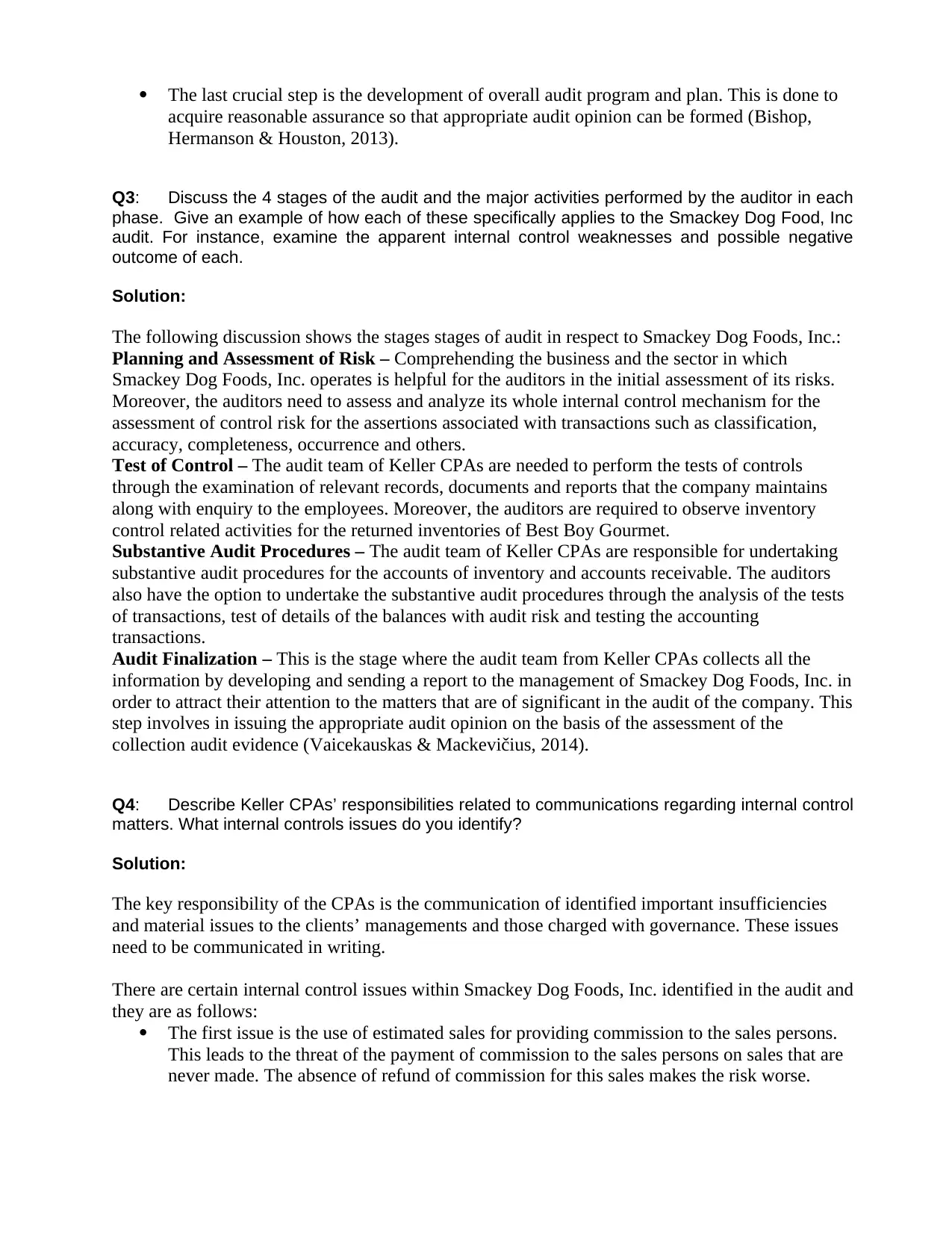
The last crucial step is the development of overall audit program and plan. This is done to
acquire reasonable assurance so that appropriate audit opinion can be formed (Bishop,
Hermanson & Houston, 2013).
Q3: Discuss the 4 stages of the audit and the major activities performed by the auditor in each
phase. Give an example of how each of these specifically applies to the Smackey Dog Food, Inc
audit. For instance, examine the apparent internal control weaknesses and possible negative
outcome of each.
Solution:
The following discussion shows the stages stages of audit in respect to Smackey Dog Foods, Inc.:
Planning and Assessment of Risk – Comprehending the business and the sector in which
Smackey Dog Foods, Inc. operates is helpful for the auditors in the initial assessment of its risks.
Moreover, the auditors need to assess and analyze its whole internal control mechanism for the
assessment of control risk for the assertions associated with transactions such as classification,
accuracy, completeness, occurrence and others.
Test of Control – The audit team of Keller CPAs are needed to perform the tests of controls
through the examination of relevant records, documents and reports that the company maintains
along with enquiry to the employees. Moreover, the auditors are required to observe inventory
control related activities for the returned inventories of Best Boy Gourmet.
Substantive Audit Procedures – The audit team of Keller CPAs are responsible for undertaking
substantive audit procedures for the accounts of inventory and accounts receivable. The auditors
also have the option to undertake the substantive audit procedures through the analysis of the tests
of transactions, test of details of the balances with audit risk and testing the accounting
transactions.
Audit Finalization – This is the stage where the audit team from Keller CPAs collects all the
information by developing and sending a report to the management of Smackey Dog Foods, Inc. in
order to attract their attention to the matters that are of significant in the audit of the company. This
step involves in issuing the appropriate audit opinion on the basis of the assessment of the
collection audit evidence (Vaicekauskas & Mackevičius, 2014).
Q4: Describe Keller CPAs’ responsibilities related to communications regarding internal control
matters. What internal controls issues do you identify?
Solution:
The key responsibility of the CPAs is the communication of identified important insufficiencies
and material issues to the clients’ managements and those charged with governance. These issues
need to be communicated in writing.
There are certain internal control issues within Smackey Dog Foods, Inc. identified in the audit and
they are as follows:
The first issue is the use of estimated sales for providing commission to the sales persons.
This leads to the threat of the payment of commission to the sales persons on sales that are
never made. The absence of refund of commission for this sales makes the risk worse.
acquire reasonable assurance so that appropriate audit opinion can be formed (Bishop,
Hermanson & Houston, 2013).
Q3: Discuss the 4 stages of the audit and the major activities performed by the auditor in each
phase. Give an example of how each of these specifically applies to the Smackey Dog Food, Inc
audit. For instance, examine the apparent internal control weaknesses and possible negative
outcome of each.
Solution:
The following discussion shows the stages stages of audit in respect to Smackey Dog Foods, Inc.:
Planning and Assessment of Risk – Comprehending the business and the sector in which
Smackey Dog Foods, Inc. operates is helpful for the auditors in the initial assessment of its risks.
Moreover, the auditors need to assess and analyze its whole internal control mechanism for the
assessment of control risk for the assertions associated with transactions such as classification,
accuracy, completeness, occurrence and others.
Test of Control – The audit team of Keller CPAs are needed to perform the tests of controls
through the examination of relevant records, documents and reports that the company maintains
along with enquiry to the employees. Moreover, the auditors are required to observe inventory
control related activities for the returned inventories of Best Boy Gourmet.
Substantive Audit Procedures – The audit team of Keller CPAs are responsible for undertaking
substantive audit procedures for the accounts of inventory and accounts receivable. The auditors
also have the option to undertake the substantive audit procedures through the analysis of the tests
of transactions, test of details of the balances with audit risk and testing the accounting
transactions.
Audit Finalization – This is the stage where the audit team from Keller CPAs collects all the
information by developing and sending a report to the management of Smackey Dog Foods, Inc. in
order to attract their attention to the matters that are of significant in the audit of the company. This
step involves in issuing the appropriate audit opinion on the basis of the assessment of the
collection audit evidence (Vaicekauskas & Mackevičius, 2014).
Q4: Describe Keller CPAs’ responsibilities related to communications regarding internal control
matters. What internal controls issues do you identify?
Solution:
The key responsibility of the CPAs is the communication of identified important insufficiencies
and material issues to the clients’ managements and those charged with governance. These issues
need to be communicated in writing.
There are certain internal control issues within Smackey Dog Foods, Inc. identified in the audit and
they are as follows:
The first issue is the use of estimated sales for providing commission to the sales persons.
This leads to the threat of the payment of commission to the sales persons on sales that are
never made. The absence of refund of commission for this sales makes the risk worse.
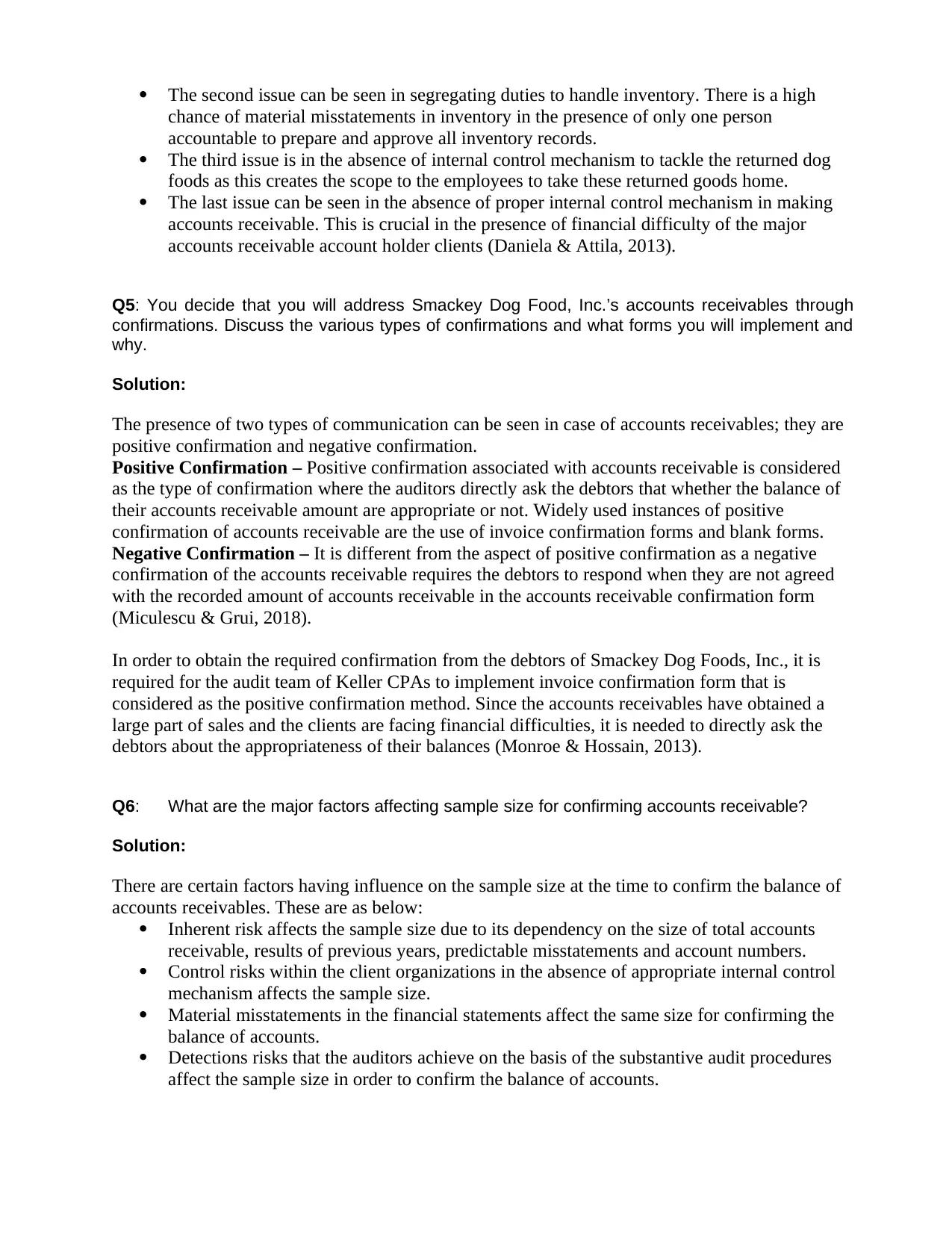
The second issue can be seen in segregating duties to handle inventory. There is a high
chance of material misstatements in inventory in the presence of only one person
accountable to prepare and approve all inventory records.
The third issue is in the absence of internal control mechanism to tackle the returned dog
foods as this creates the scope to the employees to take these returned goods home.
The last issue can be seen in the absence of proper internal control mechanism in making
accounts receivable. This is crucial in the presence of financial difficulty of the major
accounts receivable account holder clients (Daniela & Attila, 2013).
Q5: You decide that you will address Smackey Dog Food, Inc.’s accounts receivables through
confirmations. Discuss the various types of confirmations and what forms you will implement and
why.
Solution:
The presence of two types of communication can be seen in case of accounts receivables; they are
positive confirmation and negative confirmation.
Positive Confirmation – Positive confirmation associated with accounts receivable is considered
as the type of confirmation where the auditors directly ask the debtors that whether the balance of
their accounts receivable amount are appropriate or not. Widely used instances of positive
confirmation of accounts receivable are the use of invoice confirmation forms and blank forms.
Negative Confirmation – It is different from the aspect of positive confirmation as a negative
confirmation of the accounts receivable requires the debtors to respond when they are not agreed
with the recorded amount of accounts receivable in the accounts receivable confirmation form
(Miculescu & Grui, 2018).
In order to obtain the required confirmation from the debtors of Smackey Dog Foods, Inc., it is
required for the audit team of Keller CPAs to implement invoice confirmation form that is
considered as the positive confirmation method. Since the accounts receivables have obtained a
large part of sales and the clients are facing financial difficulties, it is needed to directly ask the
debtors about the appropriateness of their balances (Monroe & Hossain, 2013).
Q6: What are the major factors affecting sample size for confirming accounts receivable?
Solution:
There are certain factors having influence on the sample size at the time to confirm the balance of
accounts receivables. These are as below:
Inherent risk affects the sample size due to its dependency on the size of total accounts
receivable, results of previous years, predictable misstatements and account numbers.
Control risks within the client organizations in the absence of appropriate internal control
mechanism affects the sample size.
Material misstatements in the financial statements affect the same size for confirming the
balance of accounts.
Detections risks that the auditors achieve on the basis of the substantive audit procedures
affect the sample size in order to confirm the balance of accounts.
chance of material misstatements in inventory in the presence of only one person
accountable to prepare and approve all inventory records.
The third issue is in the absence of internal control mechanism to tackle the returned dog
foods as this creates the scope to the employees to take these returned goods home.
The last issue can be seen in the absence of proper internal control mechanism in making
accounts receivable. This is crucial in the presence of financial difficulty of the major
accounts receivable account holder clients (Daniela & Attila, 2013).
Q5: You decide that you will address Smackey Dog Food, Inc.’s accounts receivables through
confirmations. Discuss the various types of confirmations and what forms you will implement and
why.
Solution:
The presence of two types of communication can be seen in case of accounts receivables; they are
positive confirmation and negative confirmation.
Positive Confirmation – Positive confirmation associated with accounts receivable is considered
as the type of confirmation where the auditors directly ask the debtors that whether the balance of
their accounts receivable amount are appropriate or not. Widely used instances of positive
confirmation of accounts receivable are the use of invoice confirmation forms and blank forms.
Negative Confirmation – It is different from the aspect of positive confirmation as a negative
confirmation of the accounts receivable requires the debtors to respond when they are not agreed
with the recorded amount of accounts receivable in the accounts receivable confirmation form
(Miculescu & Grui, 2018).
In order to obtain the required confirmation from the debtors of Smackey Dog Foods, Inc., it is
required for the audit team of Keller CPAs to implement invoice confirmation form that is
considered as the positive confirmation method. Since the accounts receivables have obtained a
large part of sales and the clients are facing financial difficulties, it is needed to directly ask the
debtors about the appropriateness of their balances (Monroe & Hossain, 2013).
Q6: What are the major factors affecting sample size for confirming accounts receivable?
Solution:
There are certain factors having influence on the sample size at the time to confirm the balance of
accounts receivables. These are as below:
Inherent risk affects the sample size due to its dependency on the size of total accounts
receivable, results of previous years, predictable misstatements and account numbers.
Control risks within the client organizations in the absence of appropriate internal control
mechanism affects the sample size.
Material misstatements in the financial statements affect the same size for confirming the
balance of accounts.
Detections risks that the auditors achieve on the basis of the substantive audit procedures
affect the sample size in order to confirm the balance of accounts.
⊘ This is a preview!⊘
Do you want full access?
Subscribe today to unlock all pages.

Trusted by 1+ million students worldwide
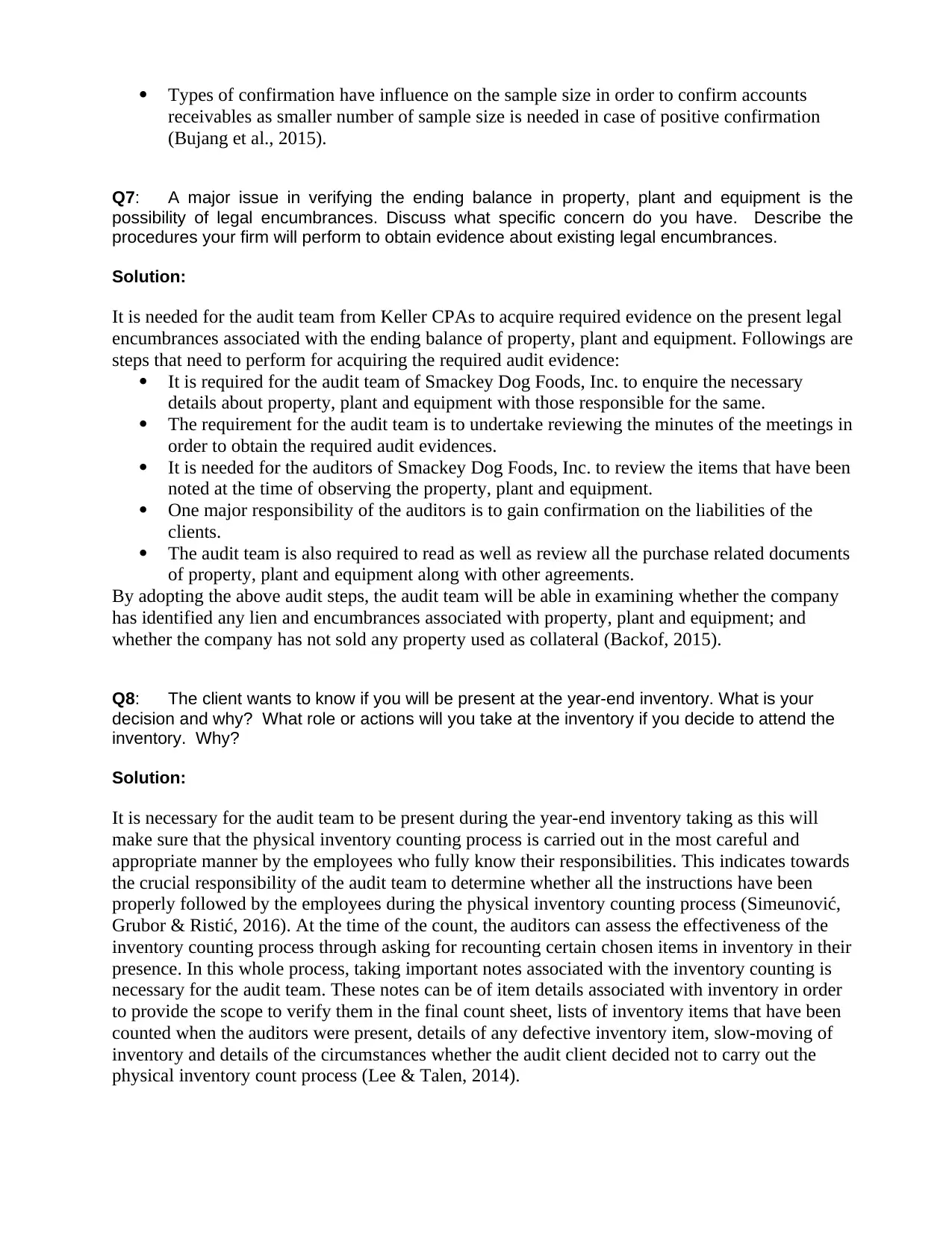
Types of confirmation have influence on the sample size in order to confirm accounts
receivables as smaller number of sample size is needed in case of positive confirmation
(Bujang et al., 2015).
Q7: A major issue in verifying the ending balance in property, plant and equipment is the
possibility of legal encumbrances. Discuss what specific concern do you have. Describe the
procedures your firm will perform to obtain evidence about existing legal encumbrances.
Solution:
It is needed for the audit team from Keller CPAs to acquire required evidence on the present legal
encumbrances associated with the ending balance of property, plant and equipment. Followings are
steps that need to perform for acquiring the required audit evidence:
It is required for the audit team of Smackey Dog Foods, Inc. to enquire the necessary
details about property, plant and equipment with those responsible for the same.
The requirement for the audit team is to undertake reviewing the minutes of the meetings in
order to obtain the required audit evidences.
It is needed for the auditors of Smackey Dog Foods, Inc. to review the items that have been
noted at the time of observing the property, plant and equipment.
One major responsibility of the auditors is to gain confirmation on the liabilities of the
clients.
The audit team is also required to read as well as review all the purchase related documents
of property, plant and equipment along with other agreements.
By adopting the above audit steps, the audit team will be able in examining whether the company
has identified any lien and encumbrances associated with property, plant and equipment; and
whether the company has not sold any property used as collateral (Backof, 2015).
Q8: The client wants to know if you will be present at the year-end inventory. What is your
decision and why? What role or actions will you take at the inventory if you decide to attend the
inventory. Why?
Solution:
It is necessary for the audit team to be present during the year-end inventory taking as this will
make sure that the physical inventory counting process is carried out in the most careful and
appropriate manner by the employees who fully know their responsibilities. This indicates towards
the crucial responsibility of the audit team to determine whether all the instructions have been
properly followed by the employees during the physical inventory counting process (Simeunović,
Grubor & Ristić, 2016). At the time of the count, the auditors can assess the effectiveness of the
inventory counting process through asking for recounting certain chosen items in inventory in their
presence. In this whole process, taking important notes associated with the inventory counting is
necessary for the audit team. These notes can be of item details associated with inventory in order
to provide the scope to verify them in the final count sheet, lists of inventory items that have been
counted when the auditors were present, details of any defective inventory item, slow-moving of
inventory and details of the circumstances whether the audit client decided not to carry out the
physical inventory count process (Lee & Talen, 2014).
receivables as smaller number of sample size is needed in case of positive confirmation
(Bujang et al., 2015).
Q7: A major issue in verifying the ending balance in property, plant and equipment is the
possibility of legal encumbrances. Discuss what specific concern do you have. Describe the
procedures your firm will perform to obtain evidence about existing legal encumbrances.
Solution:
It is needed for the audit team from Keller CPAs to acquire required evidence on the present legal
encumbrances associated with the ending balance of property, plant and equipment. Followings are
steps that need to perform for acquiring the required audit evidence:
It is required for the audit team of Smackey Dog Foods, Inc. to enquire the necessary
details about property, plant and equipment with those responsible for the same.
The requirement for the audit team is to undertake reviewing the minutes of the meetings in
order to obtain the required audit evidences.
It is needed for the auditors of Smackey Dog Foods, Inc. to review the items that have been
noted at the time of observing the property, plant and equipment.
One major responsibility of the auditors is to gain confirmation on the liabilities of the
clients.
The audit team is also required to read as well as review all the purchase related documents
of property, plant and equipment along with other agreements.
By adopting the above audit steps, the audit team will be able in examining whether the company
has identified any lien and encumbrances associated with property, plant and equipment; and
whether the company has not sold any property used as collateral (Backof, 2015).
Q8: The client wants to know if you will be present at the year-end inventory. What is your
decision and why? What role or actions will you take at the inventory if you decide to attend the
inventory. Why?
Solution:
It is necessary for the audit team to be present during the year-end inventory taking as this will
make sure that the physical inventory counting process is carried out in the most careful and
appropriate manner by the employees who fully know their responsibilities. This indicates towards
the crucial responsibility of the audit team to determine whether all the instructions have been
properly followed by the employees during the physical inventory counting process (Simeunović,
Grubor & Ristić, 2016). At the time of the count, the auditors can assess the effectiveness of the
inventory counting process through asking for recounting certain chosen items in inventory in their
presence. In this whole process, taking important notes associated with the inventory counting is
necessary for the audit team. These notes can be of item details associated with inventory in order
to provide the scope to verify them in the final count sheet, lists of inventory items that have been
counted when the auditors were present, details of any defective inventory item, slow-moving of
inventory and details of the circumstances whether the audit client decided not to carry out the
physical inventory count process (Lee & Talen, 2014).
Paraphrase This Document
Need a fresh take? Get an instant paraphrase of this document with our AI Paraphraser

Q9: Considering the general six functions that make up the inventory and warehousing cycle
for Smackey Dog Foods, Inc., identify the related documents and/or records that would be used.
From your analysis of the internal controls related to the inventory and warehousing cycle of
Smackey Dog Foods, Inc., what internal control weaknesses exist?
Solution:
There are six general functions associated with the inventory as well as warehousing cycle of
Smackey Dog Foods, Inc.; and these items are mentioned below:
The first function is purchase order processing and the documents are quotation from
suppliers, purchase order and purchase requisitions.
The second function is purchase material receipts and the document is receiving report.
The third function is material or inventory storage and the document is requisition forms
for materials.
The fourth function is raw material processing and the documents are process cost sheet
and job cost sheet.
The fifth function is finished goods storage and the documents are sales order form and
sales invoices.
The sixth function is finished goods shipping and the documents are invoice and shipping
forms.
There are two weaknesses in the internal control associated with the inventory and warehousing
cycle of Smackey Dog Foods, Inc. they are as follows:
Smackey Dog Foods, Inc. does not have any procedure for the storage, receipt and disposal
of dog foods that were returned.
A single employee is responsible to process purchase order, purchase material receipts, raw
material and finished goods storage along with managing the documents supporting these
works. This increases the risk of internal control breach (Pierce, 2014).
Q10: Discuss if Keller CPAs or its auditors are breaching any Professional Rules of Conduct
and why or why not?
Solution:
On the basis of the provided information of Smackey Dog Foods, Inc., it is noticeable that one
member of the audit team from Keller CPAs responsible for the audit of Smackey Dog Foods, Inc.
has violated a crucial principle of Professional Rules of Conduct. More specifically, Pete who is
one of the members of the audit team has violated the principle of Confidentiality. As per the case,
Pete discussed certain details of the audit plan of Smackey Dog Foods, Inc. with Alan who is
married to Kim, one of the owners of Smackey Dog Foods, Inc. This violates the ethical principle
of confidentiality. As per the Ethical conducts and principles, it is needed for the auditors to
maintain integrity while discharging the audit responsibilities; and it is the part of the
responsibility of the auditors not to disclose any detail of the audit plan to a person who is not part
of the audit team. Therefore, this also leads to the damage of the integrity principle of Professional
Rules of Conduct by Pete (Jenkins, Popova & Sheldon, 2018).
for Smackey Dog Foods, Inc., identify the related documents and/or records that would be used.
From your analysis of the internal controls related to the inventory and warehousing cycle of
Smackey Dog Foods, Inc., what internal control weaknesses exist?
Solution:
There are six general functions associated with the inventory as well as warehousing cycle of
Smackey Dog Foods, Inc.; and these items are mentioned below:
The first function is purchase order processing and the documents are quotation from
suppliers, purchase order and purchase requisitions.
The second function is purchase material receipts and the document is receiving report.
The third function is material or inventory storage and the document is requisition forms
for materials.
The fourth function is raw material processing and the documents are process cost sheet
and job cost sheet.
The fifth function is finished goods storage and the documents are sales order form and
sales invoices.
The sixth function is finished goods shipping and the documents are invoice and shipping
forms.
There are two weaknesses in the internal control associated with the inventory and warehousing
cycle of Smackey Dog Foods, Inc. they are as follows:
Smackey Dog Foods, Inc. does not have any procedure for the storage, receipt and disposal
of dog foods that were returned.
A single employee is responsible to process purchase order, purchase material receipts, raw
material and finished goods storage along with managing the documents supporting these
works. This increases the risk of internal control breach (Pierce, 2014).
Q10: Discuss if Keller CPAs or its auditors are breaching any Professional Rules of Conduct
and why or why not?
Solution:
On the basis of the provided information of Smackey Dog Foods, Inc., it is noticeable that one
member of the audit team from Keller CPAs responsible for the audit of Smackey Dog Foods, Inc.
has violated a crucial principle of Professional Rules of Conduct. More specifically, Pete who is
one of the members of the audit team has violated the principle of Confidentiality. As per the case,
Pete discussed certain details of the audit plan of Smackey Dog Foods, Inc. with Alan who is
married to Kim, one of the owners of Smackey Dog Foods, Inc. This violates the ethical principle
of confidentiality. As per the Ethical conducts and principles, it is needed for the auditors to
maintain integrity while discharging the audit responsibilities; and it is the part of the
responsibility of the auditors not to disclose any detail of the audit plan to a person who is not part
of the audit team. Therefore, this also leads to the damage of the integrity principle of Professional
Rules of Conduct by Pete (Jenkins, Popova & Sheldon, 2018).
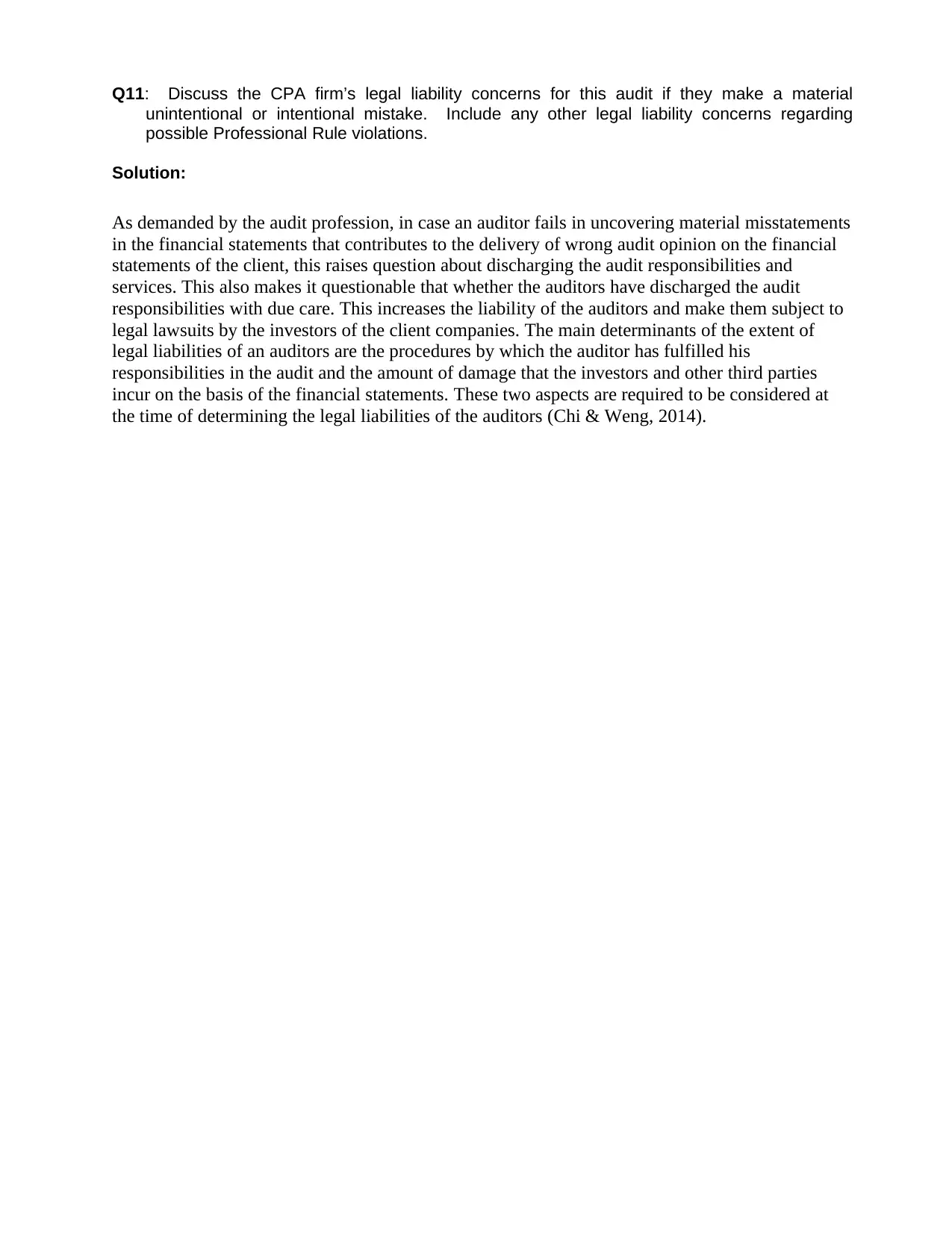
Q11: Discuss the CPA firm’s legal liability concerns for this audit if they make a material
unintentional or intentional mistake. Include any other legal liability concerns regarding
possible Professional Rule violations.
Solution:
As demanded by the audit profession, in case an auditor fails in uncovering material misstatements
in the financial statements that contributes to the delivery of wrong audit opinion on the financial
statements of the client, this raises question about discharging the audit responsibilities and
services. This also makes it questionable that whether the auditors have discharged the audit
responsibilities with due care. This increases the liability of the auditors and make them subject to
legal lawsuits by the investors of the client companies. The main determinants of the extent of
legal liabilities of an auditors are the procedures by which the auditor has fulfilled his
responsibilities in the audit and the amount of damage that the investors and other third parties
incur on the basis of the financial statements. These two aspects are required to be considered at
the time of determining the legal liabilities of the auditors (Chi & Weng, 2014).
unintentional or intentional mistake. Include any other legal liability concerns regarding
possible Professional Rule violations.
Solution:
As demanded by the audit profession, in case an auditor fails in uncovering material misstatements
in the financial statements that contributes to the delivery of wrong audit opinion on the financial
statements of the client, this raises question about discharging the audit responsibilities and
services. This also makes it questionable that whether the auditors have discharged the audit
responsibilities with due care. This increases the liability of the auditors and make them subject to
legal lawsuits by the investors of the client companies. The main determinants of the extent of
legal liabilities of an auditors are the procedures by which the auditor has fulfilled his
responsibilities in the audit and the amount of damage that the investors and other third parties
incur on the basis of the financial statements. These two aspects are required to be considered at
the time of determining the legal liabilities of the auditors (Chi & Weng, 2014).
⊘ This is a preview!⊘
Do you want full access?
Subscribe today to unlock all pages.

Trusted by 1+ million students worldwide
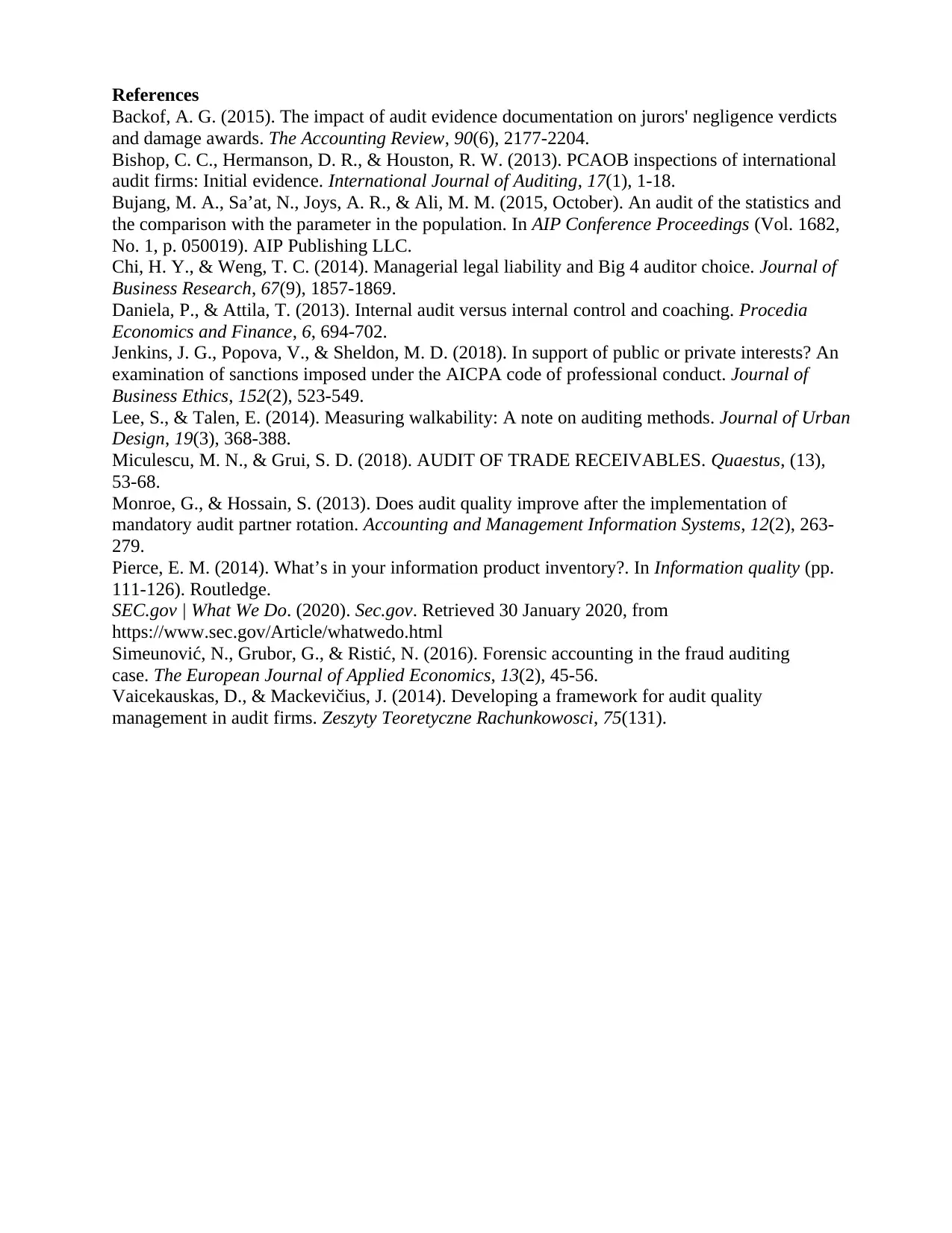
References
Backof, A. G. (2015). The impact of audit evidence documentation on jurors' negligence verdicts
and damage awards. The Accounting Review, 90(6), 2177-2204.
Bishop, C. C., Hermanson, D. R., & Houston, R. W. (2013). PCAOB inspections of international
audit firms: Initial evidence. International Journal of Auditing, 17(1), 1-18.
Bujang, M. A., Sa’at, N., Joys, A. R., & Ali, M. M. (2015, October). An audit of the statistics and
the comparison with the parameter in the population. In AIP Conference Proceedings (Vol. 1682,
No. 1, p. 050019). AIP Publishing LLC.
Chi, H. Y., & Weng, T. C. (2014). Managerial legal liability and Big 4 auditor choice. Journal of
Business Research, 67(9), 1857-1869.
Daniela, P., & Attila, T. (2013). Internal audit versus internal control and coaching. Procedia
Economics and Finance, 6, 694-702.
Jenkins, J. G., Popova, V., & Sheldon, M. D. (2018). In support of public or private interests? An
examination of sanctions imposed under the AICPA code of professional conduct. Journal of
Business Ethics, 152(2), 523-549.
Lee, S., & Talen, E. (2014). Measuring walkability: A note on auditing methods. Journal of Urban
Design, 19(3), 368-388.
Miculescu, M. N., & Grui, S. D. (2018). AUDIT OF TRADE RECEIVABLES. Quaestus, (13),
53-68.
Monroe, G., & Hossain, S. (2013). Does audit quality improve after the implementation of
mandatory audit partner rotation. Accounting and Management Information Systems, 12(2), 263-
279.
Pierce, E. M. (2014). What’s in your information product inventory?. In Information quality (pp.
111-126). Routledge.
SEC.gov | What We Do. (2020). Sec.gov. Retrieved 30 January 2020, from
https://www.sec.gov/Article/whatwedo.html
Simeunović, N., Grubor, G., & Ristić, N. (2016). Forensic accounting in the fraud auditing
case. The European Journal of Applied Economics, 13(2), 45-56.
Vaicekauskas, D., & Mackevičius, J. (2014). Developing a framework for audit quality
management in audit firms. Zeszyty Teoretyczne Rachunkowosci, 75(131).
Backof, A. G. (2015). The impact of audit evidence documentation on jurors' negligence verdicts
and damage awards. The Accounting Review, 90(6), 2177-2204.
Bishop, C. C., Hermanson, D. R., & Houston, R. W. (2013). PCAOB inspections of international
audit firms: Initial evidence. International Journal of Auditing, 17(1), 1-18.
Bujang, M. A., Sa’at, N., Joys, A. R., & Ali, M. M. (2015, October). An audit of the statistics and
the comparison with the parameter in the population. In AIP Conference Proceedings (Vol. 1682,
No. 1, p. 050019). AIP Publishing LLC.
Chi, H. Y., & Weng, T. C. (2014). Managerial legal liability and Big 4 auditor choice. Journal of
Business Research, 67(9), 1857-1869.
Daniela, P., & Attila, T. (2013). Internal audit versus internal control and coaching. Procedia
Economics and Finance, 6, 694-702.
Jenkins, J. G., Popova, V., & Sheldon, M. D. (2018). In support of public or private interests? An
examination of sanctions imposed under the AICPA code of professional conduct. Journal of
Business Ethics, 152(2), 523-549.
Lee, S., & Talen, E. (2014). Measuring walkability: A note on auditing methods. Journal of Urban
Design, 19(3), 368-388.
Miculescu, M. N., & Grui, S. D. (2018). AUDIT OF TRADE RECEIVABLES. Quaestus, (13),
53-68.
Monroe, G., & Hossain, S. (2013). Does audit quality improve after the implementation of
mandatory audit partner rotation. Accounting and Management Information Systems, 12(2), 263-
279.
Pierce, E. M. (2014). What’s in your information product inventory?. In Information quality (pp.
111-126). Routledge.
SEC.gov | What We Do. (2020). Sec.gov. Retrieved 30 January 2020, from
https://www.sec.gov/Article/whatwedo.html
Simeunović, N., Grubor, G., & Ristić, N. (2016). Forensic accounting in the fraud auditing
case. The European Journal of Applied Economics, 13(2), 45-56.
Vaicekauskas, D., & Mackevičius, J. (2014). Developing a framework for audit quality
management in audit firms. Zeszyty Teoretyczne Rachunkowosci, 75(131).
1 out of 7
Related Documents
Your All-in-One AI-Powered Toolkit for Academic Success.
+13062052269
info@desklib.com
Available 24*7 on WhatsApp / Email
![[object Object]](/_next/static/media/star-bottom.7253800d.svg)
Unlock your academic potential
Copyright © 2020–2025 A2Z Services. All Rights Reserved. Developed and managed by ZUCOL.





